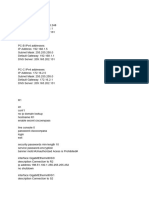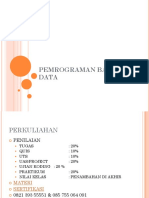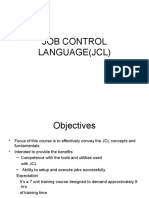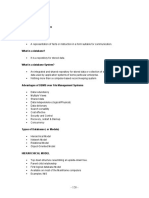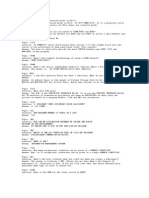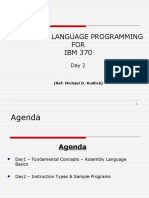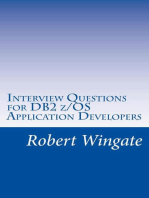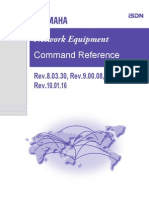VSAM Sample Interview Questions
VSAM Sample Interview Questions
Uploaded by
Varun ViswanathanCopyright:
Available Formats
VSAM Sample Interview Questions
VSAM Sample Interview Questions
Uploaded by
Varun ViswanathanOriginal Description:
Original Title
Copyright
Available Formats
Share this document
Did you find this document useful?
Is this content inappropriate?
Copyright:
Available Formats
VSAM Sample Interview Questions
VSAM Sample Interview Questions
Uploaded by
Varun ViswanathanCopyright:
Available Formats
VSAM 1. What are the different types of VSAM files available?
ESDS: Entry Sequence Data Set KSDS: Key Sequence Data Set RRDS: Relative Data Set LDS: Linear Data Set 2. What is IDCAMS? IDCAMS is the Access Method Services program. You run the IDCAMS program and supply AMS commands thru SYSIN. (Examples of AMS commands are DELETE, DEFINE, REPRO etc...). 3. Can AMS commands be run from the TSO prompt ? Yes 4. Syntax of AMS modal commands? Note: these can be used only under IDCAMS and not from the TSO prompt. IF LASTCC (or MAXCC) > (or <, = etc...) value THEN DO Command set (such as DELETE, DEFINE etc..) ELSE DO Command set LASTCC - Condition code from the last function (such as delete) executed MAXCC - Max condition code that was returned by any of the prev functions SET is also a valid AMS command. SET LASTCC (or MAXCC) = value The maximum condition code is 16. A cond code of 4 indicates a warning. A cond code of 8 is usually encountered on a DELETE of a dataset that is not present. 5. Under IDCAMS , multiple functions can be executed, each of which returns a cond code. What will be the condition code returned to the operating system ?
The maximum condition code generated is returned as the condition code of the IDCAMS step. 6. What is Control Interval, Control Area ? Control Interval is analogous to a physical block for QSAM files. It is the unit of i/o. must be between 512 bytes to 32 k. usually either 2K or 4K. A larger control interval increases performance for sequential processing while the reverse is true for random access. Under CICS when a record is locked, the entire CI gets locked. Control area is a group of control intervals. CA is used during allocation. CA size is calculated based on the allocation type (cyl, tracks or records) and can be max of 1 cylinder 7. What is FREESPACE? Coded in the DEFINE as FREESPACE (ci ca) where ci is the percentage of each control interval to be left free for insertions, ca is the percentage of control intervals in each control area to be left empty. 8. How do you decide on optimum values for CI, FREESPACE etc..? CI size should be based on record length, type of processing. Usually CI is 4K. If record length is larger (>1K), chose 6K or 8K. FREESPACE should be large if more number of insertions are envisaged. Usual values are (20 20) when heavy updates are expected. CI size can be calculated. 9. Would you specify FREESPACE for an ESDS? No. Because you cannot insert records in an ESDS, also when you rewrite a record, it must be of the same length. Thus putting any value for free space does not make any sense. 10. What is SHAREOPTS? SHAREOPTS is a parameter in the DEFINE and specifies how an object can be shared among users. It is coded as SHAREOPTS(a b), where a is the cross region share option ie how two or more jobs on a single system can share the file, while b is the cross system share option ie how two or more jobs on different MVSes can share the file. Usual value is (2 3). 11. What is the meaning of each of the values in SHAREOPTS (2 3)? Value of 2 for cross region means that the file can be processed simultaneously by multiple users provided only one of them is an updater. Value of 3 for cross system means that any number of jobs can process the file for input or output (VSAM does nothing to ensure integrity). 12. How do you define a KSDS? DEFINE CLUSTER (cluster name) with the INDEXED parameter. Also specify the ds name for the DATA component & the ds INDEX component. Other important parms are RECORDSIZE, KEYS, SHAREOPTIONS. 13. How do you define an ALTINDX? How do you use ALTINDXs in batch, CICS pgms? DEFINE ALTERNATEINDEX. Important parameters are RELATE where you specify the base cluster name, KEYS, RECORDSIZE,SHAREOPTIONS,UNIQUEKEY(or NONUNIQUEKEY), DATA(ds name for the data component), INDEX(ds name for the index component).
Then DEFINE PATH. Important parameters are NAME (ds name for the path), PATHENTRY (ds name of the alternate index name), UPDATE (or NOUPDATE) which specifies whether an alt index is updated when a update to the base cluster takes place. Then BLDINDEX. Parameters are INDATASET (ds name of base cluster), OUTDATASET (ds name of AIX). Using alternate indexes in batch pgms: In the JCL, you must have DD stmts for the cluster and for the path(s). In the COBOL pgm, SELECT... ASSIGN TO ddname for base cluster RECORD KEY IS... ALTERNATE RECORD KEY IS... Using alternate indexes in CICS pgms: FCT entries must be created for both base cluster & the path. To read using the alternate index, use the dd name of the path in CICS file control commands. 14. What happens when you open an empty VSAM file in a COBOL program for input? A VSAM file that has never contained a record is treated as unavailable. Attempting to open for input will fail. An empty file can be opened for output only. When you open for output, COBOL will write a dummy record to the file & then delete it out. 15. How do you initialize a VSAM file before any operation? a VSAM with alternate index? Can write a dummy program that just opens the file for output & then closes it. 16. What does a file status of 02 on a VSAM indicate? Duplicate alternate key. Happens on both input and output operation 17. How do you calculate record size of an alternate cluster? Give your values for both unique and nonunique. Unique Case: 5 + ( alt-key-length + primary-key ) Nonunique Case: 5 + ( alt-key-length + n * primary-key ) where n = # of duplicate records for the alternate key ????Any one who knows - can you explain ? 18. What is the difference between sequential files and ESDS files? Sequential(QSAM) files can be created on tape while ESDS files cannot. Also, you can have ALTINDEX for an ESDS while no such facility exists for QSAM files. 19. How do you load a VSAM data set with records ? Using the REPRO command.
20. How do you define a GDG ? Use the DEFINE GENERATIONDATAGROUP command. In the same IDCAMS step, another dataset must be defined whose DCB parameters are used when new generations of the GDG are created. This dataset is known as the model dataset. The ds name of this model dataset must be the same as that of the GDG, so use a disp of keep rather than catlg and also specify space=(trk,0) 21. Do all versions of the GDG have to be of the same record length ? No, the DCB of the model dataset can be overridden when you allocate new versions. 22. How are different versions of GDG named ? base-file-name.GnnnnnV00 where nnnn= generation number (upto 255). nnnn will be 0000 for the 1st generation. 23. Suppose 3 generations of a GDG exist. How would you reference the 1 st generation in the JCL? Use GDG name(-2). 24. Suppose a generation of GDG gets created in a particular step of a proc. How would you refer the current generation in a subsequent step? What would be the disposition of this generation now? Relative generation numbers are updated only at the end of the job, not at the end of a step. To allocate a new generation, we would be using (+1) with a DISP of (NEW,CATLG,DELETE). To refer to this in a subsequent step in the same job, we would again use (+1) but with a DISP of SHR or OLD. 25. What more info you should give in the DD statement while defining the next generation of a GDG? Give (+1) as the generation number, give (new,catlg) for disp, give space parameter, can give the dcb parameter if you want to override the dcb of the model dataset. 26. Assuming that the DEFINE jcl is not available, how do you get info about a VSAM files organisation ? Use the LISTCAT command. 27. During processing of a VSAM file, some system error occurs and it is subsequently unusable . What do you do ? Run VERIFY.
You might also like
- ENSA Final Skills Exam (PTSA)Document7 pagesENSA Final Skills Exam (PTSA)Víctor Morocho MontoyaNo ratings yet
- Interview Questions for IBM Mainframe DevelopersFrom EverandInterview Questions for IBM Mainframe DevelopersRating: 1 out of 5 stars1/5 (1)
- DB2 Stored Procedure IntroductionDocument11 pagesDB2 Stored Procedure IntroductionRIDA ERLANGGANo ratings yet
- Rexx ProgsDocument10 pagesRexx ProgsRaveesh BhatNo ratings yet
- XpediterDocument23 pagesXpediterapi-27095622100% (2)
- Ims DCDocument68 pagesIms DCVivek AgarwalNo ratings yet
- VSAM For MainframesDocument25 pagesVSAM For Mainframesrahul tejNo ratings yet
- JCL - Job Control LanguageDocument207 pagesJCL - Job Control LanguageMFkarNo ratings yet
- Apostila JCLDocument126 pagesApostila JCLFrancisco Junior100% (1)
- DB2 RefresherDocument28 pagesDB2 RefresherKunalNo ratings yet
- BMC Control-M 7: A Journey from Traditional Batch Scheduling to Workload AutomationFrom EverandBMC Control-M 7: A Journey from Traditional Batch Scheduling to Workload AutomationNo ratings yet
- Viruses and Antivirus ReportDocument30 pagesViruses and Antivirus ReportSoumen GhoseNo ratings yet
- VSAMDocument19 pagesVSAMApurva Kapoor100% (1)
- VSAM QuestionsDocument31 pagesVSAM QuestionsKrishnappa NiyogiNo ratings yet
- JCL Vsam Ques BankDocument35 pagesJCL Vsam Ques BankZahid FazalNo ratings yet
- JCL Interview Questions - MainframeDocument4 pagesJCL Interview Questions - Mainframenethaji1512100% (1)
- JCL Interview QuestionsDocument5 pagesJCL Interview QuestionsJohn100% (1)
- MVS JCL Utilities Quick Reference, Third EditionFrom EverandMVS JCL Utilities Quick Reference, Third EditionRating: 5 out of 5 stars5/5 (1)
- UNIX Shell Programming Interview Questions You'll Most Likely Be AskedFrom EverandUNIX Shell Programming Interview Questions You'll Most Likely Be AskedNo ratings yet
- DB2 Interview Questions Asked in Top MNCsDocument13 pagesDB2 Interview Questions Asked in Top MNCsSatish PandeyNo ratings yet
- Interview Q&As For JCLDocument76 pagesInterview Q&As For JCLRaghuNo ratings yet
- Datacom PresentationDocument49 pagesDatacom Presentationsuzeet100% (2)
- Introduction To JCL ObjectivesDocument23 pagesIntroduction To JCL ObjectivesPradeep SrinivasanNo ratings yet
- Assembler Training (Basics) Part - 1Document133 pagesAssembler Training (Basics) Part - 1KiranNo ratings yet
- Db2 Interview QUESTIONS - Advertisement: Java Inteview Questions DB2 SQL Tutorial Mainframe Inteview QuestionsDocument21 pagesDb2 Interview QUESTIONS - Advertisement: Java Inteview Questions DB2 SQL Tutorial Mainframe Inteview Questionssroul4100% (1)
- Check Point and Restart LogicDocument4 pagesCheck Point and Restart LogicPankaj Kumar100% (1)
- Db2 Interview QuestionsDocument4 pagesDb2 Interview Questionspravin216No ratings yet
- JCL Example Sample Reference CodeDocument25 pagesJCL Example Sample Reference CodeJasiekNo ratings yet
- Client Interview Question Bank (Mainframe)Document23 pagesClient Interview Question Bank (Mainframe)snowtinNo ratings yet
- IMS-DC PresentacionDocument37 pagesIMS-DC PresentacionJose Ricardo Andrade CortesNo ratings yet
- Rexx 1.0Document13 pagesRexx 1.0Arun KumarNo ratings yet
- DB2 File Aid - A Step by Step Manual For BeginnersDocument88 pagesDB2 File Aid - A Step by Step Manual For Beginnerssxdasgu88% (8)
- TOP 40 COBOL Interview Questions PDFDocument24 pagesTOP 40 COBOL Interview Questions PDFNarayan Mahato0% (1)
- Programming Language / I: A. Craig Dixon CSC 415: Programming Languages Dr. Lyle October 9, 2001Document16 pagesProgramming Language / I: A. Craig Dixon CSC 415: Programming Languages Dr. Lyle October 9, 2001Jesus NavasNo ratings yet
- Overview of CICS and DB2 InterfaceDocument14 pagesOverview of CICS and DB2 Interfacevenu100% (3)
- Mainframe JCL Interview Questions Part 6Document5 pagesMainframe JCL Interview Questions Part 6manjulkumarNo ratings yet
- CICS Transaction Server V5.1 - User Experience Panel PDFDocument50 pagesCICS Transaction Server V5.1 - User Experience Panel PDFLeandro Gabriel LópezNo ratings yet
- Assembler TPFDocument178 pagesAssembler TPFHaribabu M100% (1)
- Job Control Language: What Is JCL ?Document66 pagesJob Control Language: What Is JCL ?rajasekharampNo ratings yet
- Cool Gen NotesDocument16 pagesCool Gen Notesmailforsumant100% (2)
- Mainframe Tips Part 1Document15 pagesMainframe Tips Part 1Anbazhagan Murugesan100% (1)
- Mainframe Interview Q & ADocument17 pagesMainframe Interview Q & AAzhag ArasuNo ratings yet
- Customer Information Control System Training Material: ICIC010.2.SLDocument196 pagesCustomer Information Control System Training Material: ICIC010.2.SLManish GautamNo ratings yet
- Ims DBDocument132 pagesIms DBJose Ricardo Andrade Cortes100% (1)
- Cobol Vsam File AccessDocument15 pagesCobol Vsam File AccessnaveenkkumarhkNo ratings yet
- CICS Channels and ContainersDocument12 pagesCICS Channels and ContainersVarun Gaur100% (1)
- Sort FinalDocument17 pagesSort FinalYeddula Padmaja ReddyNo ratings yet
- Ims DCDocument49 pagesIms DCapi-3853979100% (2)
- IBM 370 Assembly Language - Day2Document26 pagesIBM 370 Assembly Language - Day2kamakshigari123No ratings yet
- JCL ImpDocument3 pagesJCL ImpKatiyar RahulNo ratings yet
- Mainframe QuestionsDocument148 pagesMainframe QuestionsManoj ShuklaNo ratings yet
- DB2 11 for z/OS: Intermediate Training for Application DevelopersFrom EverandDB2 11 for z/OS: Intermediate Training for Application DevelopersNo ratings yet
- DB2 11 for z/OS: Basic Training for Application DevelopersFrom EverandDB2 11 for z/OS: Basic Training for Application DevelopersRating: 5 out of 5 stars5/5 (1)
- Ghid de Studiu 70 - 410 - ExamDocument105 pagesGhid de Studiu 70 - 410 - ExamBiG BearNo ratings yet
- Chapter 1 Part 2Document16 pagesChapter 1 Part 2sarimasud.awanNo ratings yet
- SAP BASIS - SAPOSCOL Operating System Monitor ConceptDocument19 pagesSAP BASIS - SAPOSCOL Operating System Monitor Conceptrkm9835No ratings yet
- Q系列RS232、RS422、RS485基礎篇 (英文) PDFDocument418 pagesQ系列RS232、RS422、RS485基礎篇 (英文) PDFwang Chen YuNo ratings yet
- Diamondrensu: Ring Size ChartDocument1 pageDiamondrensu: Ring Size ChartNatsu PolsjaNo ratings yet
- Cisco SwitchesDocument4 pagesCisco SwitchesrodolfocelisNo ratings yet
- Micro Programming ConceptsDocument2 pagesMicro Programming ConceptssaiknaramNo ratings yet
- Google VCEup - Com - Professional-Data-Engineer 2022-July-05 173qDocument64 pagesGoogle VCEup - Com - Professional-Data-Engineer 2022-July-05 173qAVENASH RNo ratings yet
- Yam Aha Command RefDocument336 pagesYam Aha Command RefGran MartinezNo ratings yet
- Information and Communication Technology Form 5Document4 pagesInformation and Communication Technology Form 5cbu6665No ratings yet
- COA Notes (Notepad)Document3 pagesCOA Notes (Notepad)Utkarsh PandeyNo ratings yet
- NGW100Document11 pagesNGW100Himanshu N. PatelNo ratings yet
- Niagara Command LineDocument2 pagesNiagara Command Linepou18615No ratings yet
- ASLR On The Line - Practical Cache Attacks On The MMUDocument15 pagesASLR On The Line - Practical Cache Attacks On The MMUovisanuNo ratings yet
- 5118.numerical Computing With IEEE Floating Point Arithmetic by Michael L. OvertonDocument121 pages5118.numerical Computing With IEEE Floating Point Arithmetic by Michael L. OvertonMsegade2No ratings yet
- Command & Conquer (TM) Generals Demo: © 2003 Electronic Arts Inc. All Rights ReservedDocument4 pagesCommand & Conquer (TM) Generals Demo: © 2003 Electronic Arts Inc. All Rights ReservedJulia FlorencioNo ratings yet
- Demonstration: Understanding Pig: HDP Developer: Apache Pig and HiveDocument26 pagesDemonstration: Understanding Pig: HDP Developer: Apache Pig and HiveNIKITA TAYALNo ratings yet
- Cvavr FeaturesheetDocument5 pagesCvavr FeaturesheetyrikkiNo ratings yet
- API ProcessDocument25 pagesAPI ProcessAbhishek RanjanNo ratings yet
- PowerStore - Software Upgrade Procedure-Update PowerStore T ModelsDocument19 pagesPowerStore - Software Upgrade Procedure-Update PowerStore T ModelsArman ShaikhNo ratings yet
- Data RepresentationDocument67 pagesData Representationcharlesma463No ratings yet
- SAP JAVA GUI Installation: For Windows InsteadDocument6 pagesSAP JAVA GUI Installation: For Windows InsteadxzmangeshNo ratings yet
- Cisco CCNP Wireless 300-360 WIDESIGN (2019) Exam Practice DumpsDocument5 pagesCisco CCNP Wireless 300-360 WIDESIGN (2019) Exam Practice DumpsDavidEButler100% (1)
- Advanced GSM/GPRS Modem For Smart Metering Applications: CommunicationsDocument2 pagesAdvanced GSM/GPRS Modem For Smart Metering Applications: Communicationsruget elektronikNo ratings yet
- CLOUD COMPUTING 3,4,5 Ques BankDocument3 pagesCLOUD COMPUTING 3,4,5 Ques BankATHUL KRISHNANo ratings yet
- Library Management System SRSDocument10 pagesLibrary Management System SRSAdrees WarriachNo ratings yet
- AWUS036H User GuideDocument30 pagesAWUS036H User Guidecb4pdfsNo ratings yet
- Assignment Cisco 2Document5 pagesAssignment Cisco 2sethkartikeya08No ratings yet
